I’ve heard this type of story hundreds of times. Every time I hear a new one, I think about how I’m going to do better at backing up my own work. I still don’t do a great job, but I do have all of my files backed up in one way or another. If I had a major data loss, I could replace most of my work pretty quickly.
Backing Up For Free
Personally, I’m a big fan of data storage solutions that don’t require me to pay out any of my hard-earned dollars. I routinely email copies of files to my Gmail account and I have my most important files on Dropbox. Even better, neither of these methods really requires much technical knowledge — all though there are plenty of impressive hacks to improve on both methods. There are tons of other free online storage solutions: AOL runs Xdrive. IDrive is an encrypted option, with automatic backup. Humyo offers 10 gigs of space free. But I don’t entirely trust either system entirely. My worst nightmare is losing access to my Google account suddenly — and it could happen overnight. There’s not any sort of guarantee that free back up solutions will still be around after the end of the day. Xdrive is a case in point: AOL has been trying to sell it for a while now. They haven’t had much luck and I wouldn’t be surprised if they just quietly shut their doors one day. While I’ll continue to use my free options — they’re the easiest for getting files back off of, for one thing — I do have a few other backup methods in place. Consider it a belts-and-suspenders situation.
Backing Up For Minimal Expense
In college, I backed up my important documents through the power of drag-and-drop. I bought an external hard drive — cheaper now, but not especially expensive even several years ago if you waited for sales. I dragged my folders over to the appropriate drive and went off to do something else. With the help of someone more adept at Linux than myself, that situation has improved. Sitting next to my main tower these days is a smaller box without any bells and whistles beyond a really big hard drive. Once a week, that puppy gets fired up and we run an rsync script which backs up everything on the computer I actually work on. For those not familiar with rsync, it’s a free piece of software. It can be ran in three different ways The script runs just fine on Macs. I don’t have a Windows system at this point but rsync seems to work with Windows — though it seems to require just a little bit more work, especially if you want it to run automatically. For those people less interest in mucking around with command lines and scripts, there are some fairly user-friendly computer applications available that handle automatically backing up your data to the location of your choice. Windows users: I’ve heard lots of good things about SyncBack (available in both paid and free versions). If you’re backing up to a remote location via FTP, SyncBack can handle that with ease. Mac users: It doesn’t get easier than Time Machine. Pretty much all you have to do is connect an external hard drive to your computer and open up the Time Machine application. For all these options, your only real expense is a hard drive on which to back up your data. I generally believe that you should replace your hard drive every three to five years — but I haven’t shelled out for a RAID-quality or server-grade hard drive. Honestly, if you aren’t putting too much wear and tear on your back up hard drive, I don’t see the need for better quality, especially since big hard drives just keep getting cheaper. I know plenty of people who rely on thumb drives to back up their files, as well — at least in between larger back ups. They’re definitely cheaper than an extra hard drive, but I’ve always thought of them as less reliable. It’s not so much that I think they’re prone to failure — I just think they’re easier to lose than a larger hard drive and I don’t want to worry about leaving my only back up of a file at school or work.
I Use Both
I find it worth my while to back up my files to one of the online options and to my own back up machine. While there are plenty of disasters that can happen to online storage, there are just as many that can occur at home. Insurance might cover replacing a back up hard drive if it’s stolen — but it won’t bring back all your data. Using both methods provides you with the necessary belt-and-suspenders protection. Do you back up your files? Please let me know about any other great back up options I may have missed in the comments.
